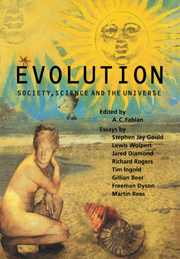Book contents
- Frontmatter
- Contents
- Introduction
- 1 On Transmuting Boyle's Law to Darwin's Revolution
- 2 The Evolution of Cellular Development
- 3 The Evolution of Guns and Germs
- 4 The Evolution of London
- 5 The Evolution of Society
- 6 The Evolution of the Novel
- 7 The Evolution of Science
- 8 The Evolution of the Universe
- Notes on Contributors
- Acknowledgements
- Index
1 - On Transmuting Boyle's Law to Darwin's Revolution
Published online by Cambridge University Press: 25 January 2010
- Frontmatter
- Contents
- Introduction
- 1 On Transmuting Boyle's Law to Darwin's Revolution
- 2 The Evolution of Cellular Development
- 3 The Evolution of Guns and Germs
- 4 The Evolution of London
- 5 The Evolution of Society
- 6 The Evolution of the Novel
- 7 The Evolution of Science
- 8 The Evolution of the Universe
- Notes on Contributors
- Acknowledgements
- Index
Summary
Adaptive continuity
Perhaps there will not always be an England (particularly on time scales favoured by palaeontologists), but a few miles of Channel and nearly a thousand years of freedom from full-scale invasion (1066 and all that) have produced a plethora of British distinctions, both idiosyncratic and deeply philosophical, from continental preferences and modes of thought. (A common language across 3000 miles of ocean can inspire more closeness than twenty miles of La Manche accompanied by a divergence of tongues – hence the similarities between American and British histories of evolutionary thought, as discussed in this article.) In this work, I try to identify adaptation as the most distinctly anglophonic subject of natural history and subsequent evolutionary ideas. I set out to show that Charles Darwin's (Figure 1) decision to site his defence and mechanism of evolution in the explanation of adaptation has roots in a long tradition of English natural history and theology that never provoked much continental attention. Our current struggles over ‘ultra-Darwinian’ versus structuralist modes of thought continue the same debate and establish a particularly English continuity across several centuries.
In the operative paragraph of his Introduction to The Origin of Species, Charles Darwin stated (1859, p. 3) that the classical subjects of natural history could provide sufficient evidence for the factuality of evolution:
In considering the Origin of Species, it is quite conceivable that a naturalist, reflecting on the mutual affinities of organic beings, on their embryological relations, their geographic distribution, geological succession, and other such facts, might come to the conclusion that each species had not been independently created, but had descended, like varieties, from other species.
- Type
- Chapter
- Information
- EvolutionSociety, Science and the Universe, pp. 4 - 27Publisher: Cambridge University PressPrint publication year: 1998
- 1
- Cited by



